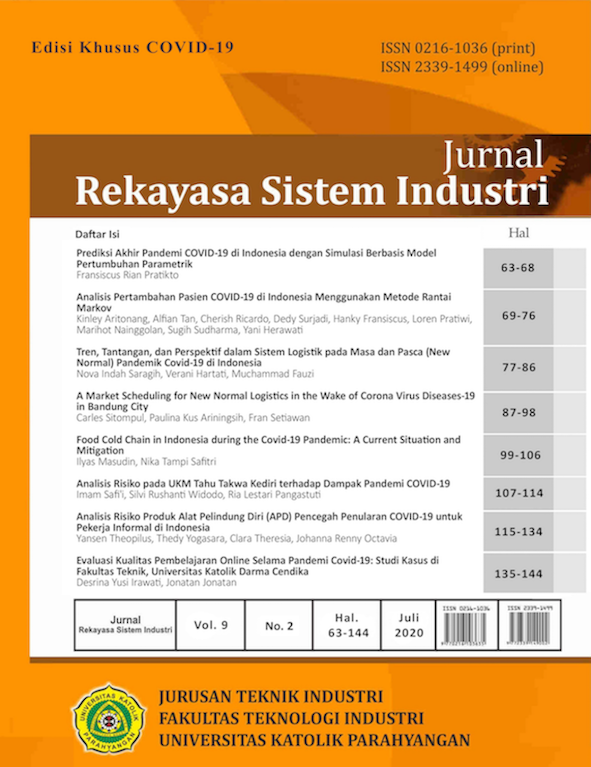Analisis Pertambahan Pasien COVID-19 di Indonesia Menggunakan Metode Rantai Markov
DOI:
https://doi.org/10.26593/jrsi.v9i2.3998.69-76Abstract
COVID-19 is a new disease that is affecting almost all of the world. Until now there has not been a single drug (vaccine) that can be used to cure it. Many attempts were made to prevent the spread of this disease but COVID-19 patients are increasing every day, although at the same time some are recovering. This study will calculate the probability of additional patients occurring over a long period of time, referred as a steady state state condition, using the Markov chain method. Nine states have been formed to represent the daily increase ranges of COVID-19 patients number. The calculation results show that the possibility of additional patient number between 1 to 91, 92 to 182, 182 to 272, 273 to 363, 364 to 454, 455 to 545, 546 to 636, 637 to 727, or greater than 728 people a day are 0.21197, 0.05644, 0.08408, 0.16337, 0.13999, 0.14512, 0.07189, 0.07695, and 0.05014, respectively.References
Berawi, M. A., Suwartha, N., Kusrini, E., Yuwono, A. H., Harwahyu, R., Setiawan, E. A., Yatmo, Y. A., Atmodiwirjo, P., Zagloel, Y. T., & Suryanegara, M. (2020). Tackling the COVID-19 Pandemic: Managing the Cause, Spread, and Impact. International Journal of Technology, 11(2), 209–214.
Fong, J. M. N., & Devanand, A. (2020). Health Ethics in COVID-19: No Better Time for Solidarity. Singapore Medical Journal.
Gibson, G. J. (1997). Markov Chain Monte Carlo Methods for Fitting Spatiotemporal Stochastic Models in Plant Epidemiology. Journal of the Royal Statistical Society: Series C (Applied Statistics), 46(2), 215–233.
kawalcovid19.id. (2020). COVID-19 di Indonesia. Kawalcovid19.Id.
Lemey, P., Suchard, M., & Rambaut, A. (2009). Reconstructing the Initial Global Spread of a Human Influenza Pandemic: A Bayesian Spatial-temporal Model for the Global Spread of H1N1pdm. PLoS Currents, 1.
Merler, S., Ajelli, M., Fumanelli, L., Gomes, M. F. C., Piontti, A. P. y, Rossi, L., Chao, D. L., Longini, I. M., Halloran, M. E., & Vespignani, A. (2015). Spatiotemporal Spread of the 2014 Outbreak of Ebola Virus Disease in Liberia and the Effectiveness of Non-pharmaceutical Interventions: A Computational Modelling Analysis. The Lancet Infectious Diseases, 15(2), 204–211. https://doi.org/https://doi.org/10.1016/S1473-3099(14)71074-6.
Winston, W. L., & Goldberg, J. B. (2004). Operations Research: Applications and Algorithms (3rd ed.). Thomson Brooks/Cole Belmont.
Yuliana (2020). Corona Virus Disease (Covid-19): Sebuah Tinjauan Lieratur. Wellness and Healthy Magazine, 2(1), 187-192.

